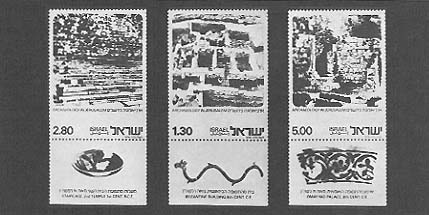
Digging into archaeological sites will probably not yield any philatelic finds, but digging into postage stamps will often yield a good deal about archaeology. Thus, Biblical archaeology buffs may be interested in a series of five stamps recently released by the Israel Philatelic Services entitled “Archaeology In Jerusalem.” The stamps, tabs and First Day envelopesa all combine to depict five major archaeological finds in Israel’s capital city. As a philatelist who has often walked through these sites, and was even privileged to participate in a dig by the Temple Mount area conducted by the renowned Benjamin Mazar, I shall try to do justice to both philately and archaeology.
Large scale archaeological digs have been carried out in Old Jerusalem since 1968 and the finds fall into two main categories. (1) architecture—city walls, buildings, steps, street sections, etc. and (2) objects—tools and implements, jewelry, coins and other ornaments. The Jerusalem digs have uncovered primarily architectural features, but the number of individual objects found has also been considerable.
The subjects of these stamps were chosen to illustrate the architectural discoveries relating to different historical periods, while the tabs of each stamp were utilized to portray objects relating to the specific site shown on the stamp. The stamps show the sites in their natural state of discovery, while the corresponding First Day envelope depicts a reconstruction of the site in its original state.
70 agora stamp—The City Walls—800–700 B.C.
On the western hill, in the area of the Jewish Quarter, a wall of astonishing thickness was uncovered. This wall dates to the period of the Kingdom of Judah and the end of the First Temple—the reign of King Hezekiah (end of the 8th century B.C.). The wall delineated for the first time the limits of the city of Jerusalem in the period of the First Temple and gave an indication of the strength of its fortifications which finally fell to Nebuchadnezzar, King of Babylon, in 586 B.C. The tab depicts a scarab bearing the likeness of a griffin, while the envelope shows a reconstruction of the city walls based on the new discoveries.
IL 2.40 stamp—Robinson’s Arch—turn of the era
Until recent discoveries, it was thought that the arch—actually the spring of an arch which barely protrudes from the wall—first discovered by the American scholar Edward Robinson, was one of seven massive arches that formed a bridge between the Upper City and the Temple area in the period of the Second Temple. From an examination of the arch itself and from a study of the adjacent excavations, it was learned that the arch was, in fact, the last link in a stair system that led from the main street at the foot of the Temple Mount to the Grand Hall at the South of the Mount, all as described by the Jewish historian, Josephus. The tab depicts a gem-bearing bowl from the Herodian period, while the envelope shows a reconstruction of the arch in the light of the recent excavations.

IL 2.80 stamp—The steps leading to the Gates of Hulda—turn of the era
The principal entrance to the Temple Mount during the Herodian period (37 B.C.–70 A.D.) was from the south face, and the south wall incorporated the Gates of Hulda which served as the main gates in the Second Temple period. Recent excavations succeeded in uncovering the steps leading to the western gate of Hulda. This find has helped clarify the route taken by the tens of thousands of pilgrims on the way from the city’s main streets and squares facing the Temple Mount, up to the Temple courtyards. The tab shows a clay bowl with highly artistic floral decorations typical of those used in Jerusalem in that period. The envelope shows a reconstruction of the south face of the Temple Mount with its gates and steps, and the streets found at its foot.
IL 1.30 stamp—Byzantine structure—6th–7th centuries A.D.
A number of villa-type dwellings which were part of the residential quarter at the foot of the Temple Mount during the 6th and 7th centuries A.D. were also uncovered. These 2- story structures were elaborately decorated and consisted of a central courtyard surrounded by rooms. The stamp illustrates one of the houses uncovered during the excavations and the tab shows the arm of a bronze lamp found in the same villa. The reconstructed villa is depicted on the First Day envelope.
IL 5.00 stamp—Corner room of Omayyad Caliphs’ palace—7th–8th centuries A.D.
The excavations of the last few years have provided evidence that the Omayyad dynasty of the late 7th and early 8th centuries A.D. built not only on the Temple Mount, but also erected grandiose public buildings outside the area. Among the royal buildings discovered, was a palace built at the foot of the Temple Mount. The stamp depicts the corner of a room containing a pillar, from the ground floor of the Caliph’s palace, and the tab illustrates part of a painted plaster wall. The envelope portrays a reconstruction of the Palace and shows where it stood in relation to the Temple Mount.
The subjects chosen for illustration on the stamps and tabs were suggested by Meir Ben-Dov, a member of the archaeological team that worked in the Temple Mount area. The stamps were based on photographs taken by Avinoam Glick.
The set of five stamps with their tabs mounted on an official First Cover can be purchased from most stamp dealers, and should cost about $3.00.
MLA Citation
Footnotes
Stamps of Israel are printed in sheets with tabs (labels) usually attached below the bottom row. The tabs contain a statement or pictorial elaboration about the stamp’s subject. The Israel Philatelic Services also prepares an official envelope for use on the first day of a stamp’s issue, which when postmarked with the new stamp affixed is referred to as a First Day Cover. The envelope usually contains an illustration pertaining to the stamp’s theme.

